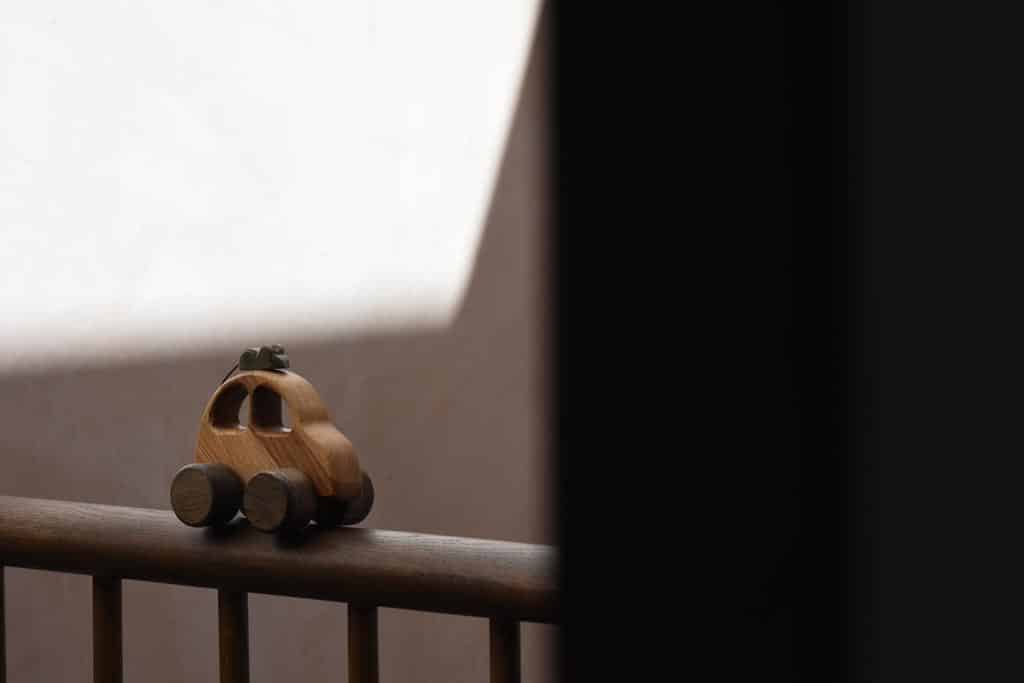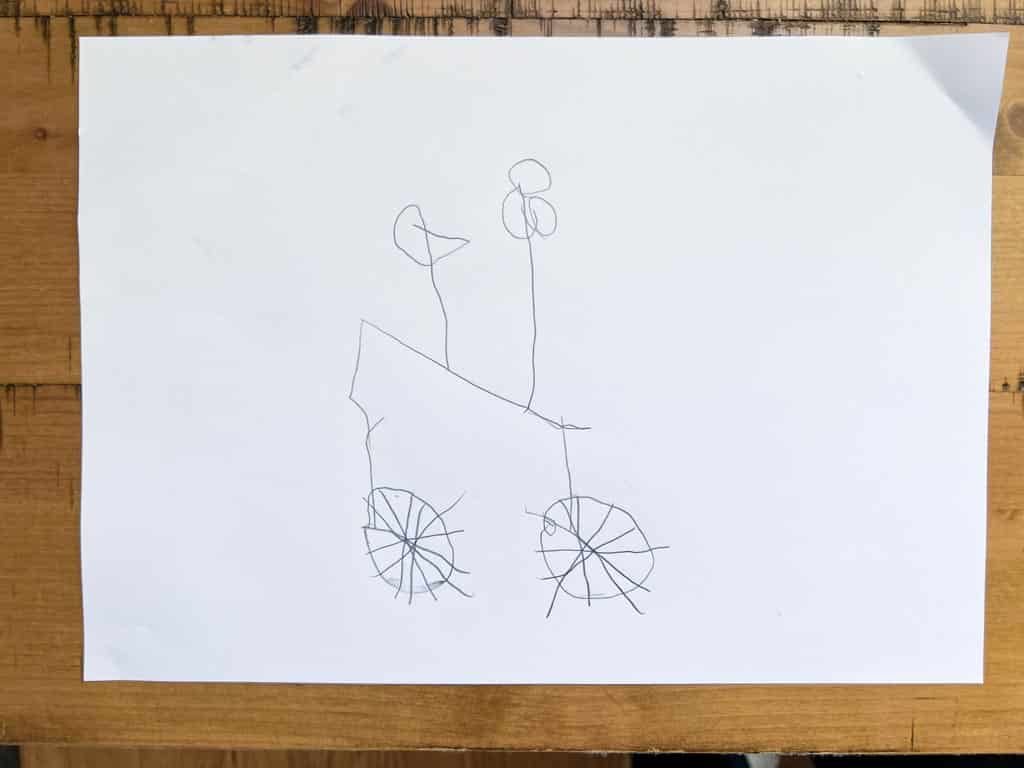Your baby sits at a basket.
She is holding a toy.
She tries to put the toy inside.
Will it fit? She doesn’t know. A squash and a squeeze. A twist and a shove. A furrowed brow.
All of a sudden, with a final push, it drops in.
Success!
A few months later, now a toddler, she crawls into a box. Can I get the whole of my body inside? she seems to wonder. She pulls in her last limb victoriously, beaming with delight.
You might have noticed that some of your child’s games are repetitive. This is schema play, a force that drives much of a child’s development in the early years.
Schemas are mental models of how things work. You can have a schema about how things connect, move or turn, for example.
Your schemas will be wrong – it’s impossible to understand big ideas first time. So you try and try again, until you work it out.
This is why play seems repetitive.
So what kind of schema is involved when a child fills boxes or climbs into openings?
The containing schema.
It’s the filling pockets schema, the putting-all-your-toys-in-a-backpack-and-carrying-them-around schema.
And it’s lots of fun.
How does the Containing Schema help my child’s development?
Filling things up helps children to understand the concept of space. They learn about sizes, shapes, and the properties of containers and the objects they can hold. It’s a masterclass in learning to problem solve.
What are the best materials to explore containing?
Toys like nesting boxes, baskets, trolleys, pots and pans, and any containers with lids can be excellent for supporting this schema. Activities such as playing with sand and water, using measuring cups, and even simple games like ‘hide and seek’ can be beneficial.
Using items like plastic bowls, empty cardboard boxes, and Tupperware can be great for containing play. Just ensure they are safe and supervise the play.
Enveloping vs Containing: What’s the Difference?
The enveloping schema involves a child wanting to cover an object or themselves completely, like wrapping a doll in a blanket. Containing, on the other hand, involves placing objects inside something else, like putting toys inside a box.
By understanding and supporting your child through the containing schema and other schemas, you are playing an active role in their cognitive development. Remember to keep the environment safe and let your child explore at their own pace.
Extending mathematical learning through containing
The containing schema is inherently linked to early mathematical learning.
Understanding size and volume
When children experiment with different-sized containers and start to recognise which objects can fit inside and which cannot they begin to understand measurement, capacity, and volume.
Spatial Awareness
How many blocks will fit into this basket? Is this ball too big to fit into the tube? These questions are of great interest to a child exploring the containing schema and they demand confident spatial reasoning. This will later be crucial in geometry and everyday problem-solving.
Counting and Quantity
The containing schema naturally involves counting. A child may count how many items they can fit into a container or compare the number of items in two different containers. This reinforces their counting skills and introduces them to the concept of quantity.
Sorting and Categorising
Often, children will not just throw any objects into containers. They might start sorting them by attributes such as colour, size, or shape before placing them inside. Sorting later leads to understanding of sets and patterns.
Predicting and Estimating
A more advanced aspect of mathematical learning through the containing schema involves prediction and estimation. For example, a child might guess how many teddy bears will fit in a basket, and then test their prediction.
Encouraging Mathematical Language
Words like “more”, “less”, “big”, “small”, “inside”, “outside”, “full”, and “empty” don’t sound especially mathematical but they are essential concepts to master before school begins.
Containing schema activities
Your child exploring the containing schema is fascinated by the idea of placing objects into containers and taking them out. They are intrigued by what can fit into spaces, containers, or enclosures and may repeatedly engage in activities that involve this concept. Here are some examples of games and activities your child might enjoy:
- Nesting Cups or Boxes: Provide your child with nesting cups or boxes, and watch as they delight in putting smaller cups inside bigger ones.
- Packing a Bag: Give your child a small bag or backpack along with various items, and encourage them to pack items inside.
- Hide and Seek with Objects: Hide small toys in a box or container and have your child find them. They’ll love the surprise of discovering hidden treasures.
- Filling and Emptying: Set up a tub of water with various cups and containers. Your child will have tons of fun filling and emptying them.
- Sorting Objects into Containers: Encourage your child to sort toys or objects into different containers based on color, size, or type.
- Playing with Pots and Pans: Let your child use kitchen pots and pans to put things in and take them out. It’s simple, but they’ll find it incredibly engaging.
- Sand Play: At the sandbox, give your child buckets so they can create sandcastles or simply fill the buckets up and empty them.
- Toy Garages or Barns: If your child has a toy garage or barn, encourage them to put toy cars or animals in and take them out.
- Laundry Day Game: Give your child a small laundry basket and some clothes for a game of ‘doing the laundry’ – putting them in and taking them out.
- Egg Carton Sorting: Use an empty egg carton for your child to sort and store small items like beads, buttons, or pom-poms.
What’s the difference between the containing and enveloping schemas?
Containing is often considered part of enveloping but there are subtle differences.
Enveloping Schema
The focus is on enclosing an object entirely, so that it is hidden or enveloped by something else, often wrapped or covered in some way . Children engaging in enveloping behaviours might:
- Wrap toys in a blanket or cloth.
- Enjoy being wrapped in a towel or blanket themselves.
- Cover a toy with Play-Doh or clay.
- Paint over a whole sheet of paper with no white showing.
The enveloping schema helps children to understand concepts such as object permanence (knowing an object still exists even if it’s hidden) and the properties of materials that can be used to enclose or cover other objects.
Containing Schema
The containing schema, on the other hand, involves a child’s fascination with placing objects into containers and exploring the space inside. In this schema, the focus is not on hiding the object but on seeing how objects fit into different spaces. Children engaging in containing behaviours might:
- Put toys into boxes, buckets, or cups.
- Climb into boxes or hide in small spaces themselves.
- Enjoy playing with nesting toys or stacking cups.
- Put lids on pots or caps on bottles.
The containing schema helps children to explore spatial relationships, understand the properties of containers, and learn about concepts like in, out, full, and empty.
Final word
This phase of development is brimming with opportunities for learning. As parents, being aware of your child’s schema play can help you to foster an environment that is not only engaging but enriching.
You can support your child by providing them with materials and toys that stimulate their curiosity in containing. Being mindful of safety, everyday items like pots, containers, and boxes can be incredible assets for play.
Talk with your child about what they are doing, introduce them to words that explain their actions and relate to space, size, and number. For example, use words like “inside”, “big”, “small”, “more”, or “fewer”. This enhances their language skills and conceptual understanding.
Remember, it’s not about steering your child in a particular direction, but rather giving them the space and tools to explore the containing schema on their own terms. Encourage creativity, be open to their experiments, and most importantly, have fun alongside them.





